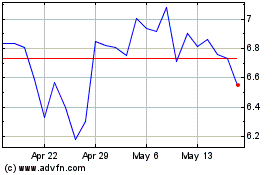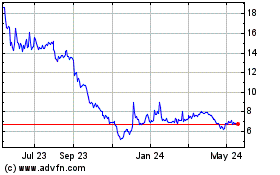Kala Pharmaceuticals, Inc. (NASDAQ:KALA), a commercial-stage
biopharmaceutical company focused on the discovery, development and
commercialization of innovative therapies for diseases of the eye,
today announced that it has entered into a definitive agreement to
sell its commercial portfolio and related intellectual property
assets to Alcon Inc. This includes EYSUVIS, the first and only U.S.
Food and Drug Administration (FDA) approved medicine for the
short-term (up to two weeks) treatment of the signs and symptoms of
dry eye disease, and INVELTYS, a twice-a-day corticosteroid for the
treatment of post-operative inflammation and pain following ocular
surgery.
“The sale of EYSUVIS and INVELTYS is an important step as we
execute on our strategic plan and pursue our mission of delivering
innovative therapies that can address significant unmet needs in
ophthalmology,” said Mark Iwicki, Chief Executive Officer and
Chairman of Kala. “Alcon is an ideal partner to expand the reach of
our commercial assets. Alcon has a decades-long history of
delivering market-leading vision care to patients around the world
and benefits from robust franchises in dry eye disease and surgical
care, making them deeply familiar with eye care professionals and
the patients EYSUVIS and INVELTYS are intended to treat. We look
forward to working with Alcon through this transition and,
ultimately, to devoting our internal resources to developing
innovative therapies, including KPI-012, to further transform the
treatment of eye diseases.”
Kala plans to focus on developing KPI-012, a novel cell-free
secretome therapy that has the potential to address a number of
rare and severe ocular diseases. Subject to the submission and
clearance of an investigational new drug application for KPI-012,
Kala expects to initiate a Phase 2/3 clinical trial of KPI-012 for
persistent corneal epithelial defect (PCED) in the fourth quarter
of 2022 and plans to expand its development program for KPI-012
into additional front and back of the eye indications, with
additional details forthcoming in the months ahead. Following the
closing of the sale of its commercial assets, Kala expects to
realize a substantial reduction in operating expenses, which
together with the net proceeds from the upfront cash payment
received from this transaction, will extend Kala’s operating cash
runway into the second quarter of 2024, beyond the expected KPI-012
Phase 2/3 data readout.
Under the terms of the asset purchase agreement, Kala will
receive an upfront payment of $60 million and will be eligible to
receive commercial-based sales milestone payments. Kala anticipates
the transaction will close in the third quarter of 2022, subject to
certain conditions, including the expiration of the waiting period
under the Hart-Scott-Rodino Antitrust Improvements Act and other
customary closing conditions.
Piper Sandler acted as the exclusive financial advisor, and
Wilmer Cutler Pickering Hale and Dorr LLP served as legal counsel
to Kala.
About EYSUVIS:EYSUVIS (loteprednol etabonate
ophthalmic suspension) 0.25% is approved for the short-term (up to
two weeks) treatment of the signs and symptoms of dry eye disease.
EYSUVIS utilizes Kala's AMPPLIFY® mucus-penetrating particle (MPP)
Drug Delivery Technology to enhance penetration of loteprednol
etabonate (LE) into target tissue of the ocular surface. In
preclinical studies, the AMPPLIFY Drug Delivery Technology
increased delivery of LE into target ocular tissues more than
three-fold compared to an active LE comparator by facilitating
penetration through the tear film mucins. EYSUVIS was approved by
the FDA on October 26, 2020. Kala believes that EYSUVIS' broad
mechanism of action, rapid onset of relief of both signs and
symptoms, favorable tolerability and safety profile and the
potential to be complementary to existing therapies, offer a
differentiated product profile for the short-term treatment of dry
eye disease, including the management of dry eye flares.
EYSUVIS, as with other ophthalmic corticosteroids, is
contraindicated in most viral diseases of the cornea and
conjunctiva including epithelial herpes simplex keratitis
(dendritic keratitis), vaccinia, and varicella, and also in
mycobacterial infection of the eye and fungal diseases of ocular
structures. The initial prescription and each renewal of the
medication order should be made by a physician only after
examination of the patient with the aid of magnification, such as
slit lamp biomicroscopy, and, where appropriate, fluorescein
staining. Prolonged use of corticosteroids may result in glaucoma
with damage to the optic nerve, as well as defects in visual acuity
and fields of vision. Corticosteroids should be used with caution
in the presence of glaucoma. Renewal of the medication order should
be made by a physician only after examination of the patient and
evaluation of the IOP. Use of corticosteroids may result in
posterior subcapsular cataract formation. Use of corticosteroids
may suppress the host response and thus increase the hazard of
secondary ocular infections. In acute purulent conditions,
corticosteroids may mask infection or enhance existing infection.
Use of a corticosteroid medication in the treatment of patients
with a history of herpes simplex requires great caution. Use of
ocular corticosteroids may prolong the course and may exacerbate
the severity of many viral infections of the eye (including herpes
simplex). Fungal infections of the cornea are particularly prone to
develop coincidentally with long-term local corticosteroid
application. Fungus invasion must be considered in any persistent
corneal ulceration where a corticosteroid has been used or is in
use. The most common adverse drug reaction following the use of
EYSUVIS for two weeks was instillation site pain, which was
reported in 5% of patients.
Please see full Prescribing Information at www.eysuvis.com.
About INVELTYS:INVELTYS (loteprednol etabonate
ophthalmic suspension) 1% is a twice-a-day corticosteroid for the
treatment of post-operative inflammation and pain following ocular
surgery. INVELTYS utilizes Kala’s proprietary AMPPLIFY
mucus-penetrating particle (MPP) Drug Delivery Technology to
enhance penetration of loteprednol etabonate (LE) into target
tissues of the eye. In preclinical studies, the AMPPLIFY Drug
Delivery Technology increased delivery of LE into target ocular
tissues more than three-fold compared to an active LE comparator by
facilitating penetration through the tear film mucins. INVELTYS was
approved by the FDA on August 22, 2018. Kala believes INVELTYS has
a favorable profile for the treatment of inflammation and pain
following ocular surgery, due to its twice-a-day dosing
regimen.
INVELTYS, as with other ophthalmic corticosteroids, is
contraindicated in most viral diseases of the cornea and
conjunctiva including epithelial herpes simplex keratitis
(dendritic keratitis), vaccinia, and varicella, and also in
mycobacterial infection of the eye and fungal diseases of ocular
structures. A prolonged use of corticosteroids may result in
glaucoma with damage to the optic nerve, defects in visual acuity
and fields of vision. If this product is used for 10 days or
longer, IOP should be monitored. Use of corticosteroids may result
in posterior subcapsular cataract formation. Use of steroids after
cataract surgery may delay healing and increase the incidence of
bleb formation. In those diseases causing thinning of the cornea or
sclera, perforations have been known to occur with the use of
topical steroids. The initial prescription and renewal of the
medication order should be made by a physician only after
examination of the patient with the aid of magnification such as
slit lamp biomicroscopy and, where appropriate, fluorescein
staining. Prolonged use of corticosteroids may suppress the host
response and thus increase the hazard of secondary ocular
infections. In acute purulent conditions, steroids may mask
infection or enhance existing infection. Use of a corticosteroid
medication in the treatment of patients with a history of herpes
simplex requires great caution. Use of ocular steroids may prolong
the course and may exacerbate the severity of many viral infections
of the eye (including herpes simplex). Fungal infections of the
cornea are particularly prone to develop coincidentally with
long-term local steroid application. Fungus invasion must be
considered in any persistent corneal ulceration where a steroid has
been used or is in use. In clinical trials, the most common adverse
drug reactions were eye pain (1%) and posterior capsular
opacification (1%). These reactions may have been the consequence
of the surgical procedure.
Please see full Prescribing Information at
www.inveltys.com.
About Kala Pharmaceuticals,
Inc.Kala is a commercial-stage biopharmaceutical company
focused on the discovery, development, and commercialization of
innovative therapies for diseases of the eye. Kala has applied its
AMPPLIFY® mucus-penetrating particle (MPP) Drug Delivery
Technology to two ocular therapies, EYSUVIS® (loteprednol
etabonate ophthalmic suspension) 0.25% and
INVELTYS® (loteprednol etabonate ophthalmic suspension) 1%.
The Company also has a pipeline of development programs including a
clinical-stage secretome product candidate, KPI-012, initially
targeting persistent corneal epithelial defects (PCED) and multiple
proprietary new chemical entity (NCE) preclinical development
programs targeted to address unmet medical needs, including both
front and back of the eye diseases. For more information on Kala,
please visit www.kalarx.com.
Forward Looking Statements:This
press release contains forward-looking statements within the
meaning of the Private Securities Litigation Reform Act of 1995
that involve substantial risks and uncertainties. Any statements in
this press release about Kala’s future expectations, plans and
prospects, including but not limited to statements about Kala’s
ability to consummate the transaction with Alcon, primarily
focusing its resources on the development of innovative therapies,
including KPI-012, and reducing costs, Kala’s plans to expand its
development program for KPI-012 to address additional front and
back of the eye diseases, the sufficiency of Kala’s cash resources
and other statements containing the words “anticipate,” “believe,”
“estimate,” “expect,” “intend,” “may,” “plan,” “predict,”
“project,” “target,” “potential,” “likely,” “will,” “would,”
“could,” “should,” “continue,” and similar expressions constitute
forward-looking statements. Actual results may differ materially
from those indicated by such forward-looking statements as a result
of various important factors, including: Kala’s ability to
consummate the transaction with Alcon; Kala’s ability to realize
the anticipated benefits of the transaction with Alcon, including
the uncertainty regarding the receipt of any milestone payments;
the potential for negative effects of the announcement of the
transaction with Alcon ; the risk of litigation and/or regulatory
actions related to the transaction with Alcon; the impact of
extraordinary external events, such as the current pandemic health
event resulting from the novel coronavirus (COVID-19), and their
collateral consequences, including disruption of the activities of
Kala’s sales force and the market for EYSUVIS and INVELTYS; the
uncertainties inherent in the initiation and conduct of preclinical
studies and clinical trials; availability and timing of data from
clinical trials; uncertainties associated with regulatory review of
clinical trials and applications for marketing approvals; whether
regulatory or commercial milestones are achieved; the risk that
disruption resulting from the announcement of the Alcon transaction
may adversely affect its business and business relationships,
including with employees and suppliers; the sufficiency of cash
resources and need for additional financing and other important
factors, any of which could cause the Kala’s actual results to
differ from those contained in the forward-looking statements,
discussed in the “Risk Factors” section of Kala’s Annual Report on
Form 10-K, most recently filed Quarterly Report on Form 10-Q and
other filings Kala makes with the Securities and Exchange
Commission. These forward-looking statements represent Kala’s views
as of the date of this release and should not be relied upon as
representing the Kala’s views as of any date subsequent to the date
hereof. Kala does not assume any obligation to update any
forward-looking statements, whether as a result of new information,
future events or otherwise, except as required by law.
Investor Contacts:
Jill Steierjill.steier@kalarx.com
781-996-5252
Hannah Deresiewiczhannah.deresiewicz@sternir.com
212-362-1200
KALA BIO (NASDAQ:KALA)
Historical Stock Chart
From Oct 2024 to Nov 2024

KALA BIO (NASDAQ:KALA)
Historical Stock Chart
From Nov 2023 to Nov 2024
